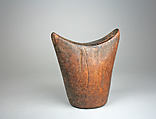Headrest
Not on view
This headrest was used by its owner to elevate their head and preserve their elaborate hairstyle during sleep. Carved from a single, solid piece of wood, this block-style rest sits on a nearly circular base. The sides slope upwards from the base, widening at the center and then tapering inwards at the summit to meet the saddle-shaped platform. The medium-brown wood of the rest is nearly black at its top and upper edges, a darkening caused by the wood’s absorption of oils from the hair and its dressings. With the exception of a few vertical checks running along the grain on its narrow sides, the headrest is unornamented.
Personal objects, headrests support the head by cradling it along the jawline, elevating it from the ground. While some regions of central and southern Africa associate headrests with dreaming and divination, they are purely practical in eastern African. Ergonomically, they align the spine, while functionally, they protect intricate hairstyles from dust or from being flattened. Hairstyles, which can take hours to create, are not simply elements of beautification, but serve as the visual representation for their wearer’s social status, age, rank, and gender. The personal nature of the headrest is reflected in the vocabulary used to describe them in two of Ethiopia’s most commonly spoken languages. In Amharic, they are known as yagertera ("pillow of my land"), while in Oromiffaa, they are called boraati ("tomorrow-you"). (Moreno 2015, 194) Even after the end of their useful life, headrests retain the traces of their owners; several examples in the Metropolitan’s collections have a dark sheen on the upper platform and sides, the result of the wood becoming imbued with butter-based hair dressings (käbbe) and other materials used to shape and condition the hair. Butter as a hair dressing and symbol of female moral status features prominently in the Sidaama myth of Queen Furra. It is said that the queen instructed female hunters to identify themselves as skilled, invincible water buffalo hunters with this hair dressing, and that they later put butter on the tree near her grave. Among the Sidaama, butter as a hair dressing retains this symbolic reference to female power. (Hamer & Hamer 1994, 189)
The oldest preserved headrests on the African continent were found in Egypt and have been dated to the second and third dynasties of the Old Kingdom (ca. 2649–2150 B.C.). Many of these ancient Egyptian headrest forms—particularly the solid block shaped rest—have parallels in east African headrests created some five millennia later. In southern and central Ethiopia, the use of headrests is believed to have started two to three-hundred years ago. Among the most common forms are the single block, the columned rest with curved platform, and the conical base with curved platform. Due to their portable nature, headrests were once used widely among the pastoralist groups of Ethiopia and other regions of eastern Africa. They are less commonly used today because many pastoralists have transitioned to sedentary farming or moved to cities. The diversity of forms in Ethiopian headrests cannot be strictly categorized by gender, or assigned to a single ethnic group; rather, every form is carved by the Oromo, Sidaama, Gurage, and other south-central Ethiopian peoples. Some shapes and ornaments are also shared with groups in nearby Kenya, Uganda, and South Sudan, reflecting the transfer of forms across the region.
Kristen Windmuller-Luna, 2016
Sylvan C. Coleman and Pam Coleman Memorial Fund Fellow in the Department of the Arts of Africa, Oceania, and the Americas
Further Reading
Dewey, William Joseph., Toshiko M. McCallum, Jerome Feldman, and Henrietta Cosentino. Sleeping Beauties: The Jerome L. Joss Collection of African Headrests at UCLA. Los Angeles: Fowler Museum of Cultural History, University of California, 1993.
Hamer, John, and Irene Hamer. "Impact of a Cash Economy on Complementary Gender Relations among the Sadāma of Ethiopia." Anthropological Quarterly 67, no. 4 (1994): 187.
Moreno, Eduardo López, and Thierry Naudin. Wooden Dreams: East African Headrests from the Eduardo López Moreno Collection. Milan: 5 Continents, 2015.
Nettleton, Anitra C. E. "East African Headrests: Identity, Form and Aesthetics." In African Dream Machines: Style, Identity and Meaning of African Headrests, 187–243. Johannesburg, South Africa: Wits University Press, 2007.
Due to rights restrictions, this image cannot be enlarged, viewed at full screen, or downloaded.
This artwork is meant to be viewed from right to left. Scroll left to view more.



